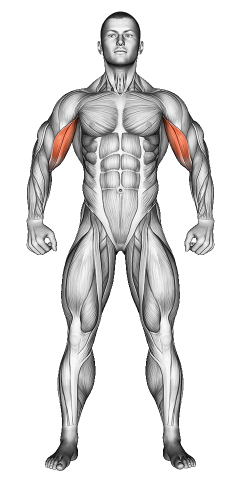Standing Dumbbell Reverse Curl: Video Tutorial & Exercise Guide

Written By: Claude Michael
Updated: Oct 13, 2024
| Workout | Standing Dumbbell Reverse Curl |
| Primary Muscle Group | Biceps |
| Secondary Muscle Group | Forearms |
| Equipment Required | Dumbbell |
| Force Type | Pull |
| Mechanics | Isolation |
| Exercise Type | Strength |
| Difficulty | Beginner |
Standing Dumbbell Reverse Curl: Video Tutorial & Exercise Guide
- 1.Standing Dumbbell Reverse Curl: Muscle Groups
- -1.1Primary Muscle Group
- -1.2Secondary Muscle Group
- 2.Standing Dumbbell Reverse Curl: Step-by-Step Guide
- 3.Standing Dumbbell Reverse Curl: Overview
- 4.Standing Dumbbell Reverse Curl: Benefits
- 5.Standing Dumbbell Reverse Curl: Pro Tips & Advanced Techniques
- 6.Standing Dumbbell Reverse Curl: Progression Plan
- 7.Standing Dumbbell Reverse Curl: Frequently Asked Questions (FAQs)
Secondary Muscles Group
Standing Dumbbell Reverse Curl: Step-by-Step Guide
- Step 1: Stand with your feet shoulder-width apart, holding a dumbbell in each hand with your arms fully extended at your sides. Your palms should be facing down (pronated grip), with your thumbs around the dumbbells.
- Step 2: Engage your core and keep your elbows close to your body. Begin curling the dumbbells upward, keeping your wrists straight and focusing on lifting with your forearms and biceps.
- Step 3: As you lift the dumbbells, maintain control and avoid swinging your arms or using momentum. Curl the weights until your forearms are almost parallel to the floor.
- Step 4: Squeeze your forearms and biceps at the top of the movement, then slowly lower the dumbbells back to the starting position, fully extending your arms.
- Step 5: Repeat the movement for the desired number of reps, maintaining proper form and control throughout.
Standing Dumbbell Reverse Curl: Overview
The Standing Dumbbell Reverse Curl is a variation of the traditional curl that emphasizes the brachioradialis, a forearm muscle, while also engaging the biceps brachii. By using a pronated (palms down) grip, this exercise shifts focus from the biceps to the forearms and the brachialis, making it highly effective for building both arm size and grip strength.
This exercise is particularly useful for individuals looking to improve forearm and grip strength, as it targets muscles often neglected by standard curls. It can also help to balance overall arm development by working both the forearms and biceps in a different range of motion.
Standing Dumbbell Reverse Curl: Benefits
The Standing Dumbbell Reverse Curl primarily targets the brachioradialis, a key muscle in the forearm, as well as the brachialis, which lies underneath the biceps. These muscles play a crucial role in forearm strength and grip, making this exercise beneficial for improving functional strength.
By using a pronated grip, this exercise reduces the focus on the biceps and shifts more of the workload to the forearms, helping to improve wrist and grip strength, which is essential for exercises like deadlifts and pull-ups.
Incorporating this movement into your routine helps build well-rounded arm strength and endurance, promoting muscle symmetry and improving your ability to handle heavier weights in other upper-body exercises.
Standing Dumbbell Reverse Curl: Pro Tips & Advanced Techniques
Keep your wrists straight throughout the movement to avoid putting unnecessary strain on your joints. Focus on controlled, slow movements to ensure full engagement of your forearms and biceps. For an added challenge, you can perform this exercise with a slower eccentric (lowering) phase to increase time under tension, or try using a barbell for more resistance. Ready to build forearm strength and grip power? Let’s curl!
Standing Dumbbell Reverse Curl: Progression Plan
Beginner
Intermediate
Advanced
Standing Dumbbell Reverse Curl: Frequently Asked Questions (FAQs)
What muscles do Standing Dumbbell Reverse Curls target?
+This exercise primarily targets the brachioradialis and brachialis, which are key muscles in the forearm and upper arm. It also engages the biceps, although to a lesser extent compared to traditional curls.
Is the Standing Dumbbell Reverse Curl suitable for beginners?
+Yes, beginners can perform this exercise with lighter weights to focus on proper form and control. It’s an excellent exercise for improving forearm and grip strength.
How can I make the Standing Dumbbell Reverse Curl more challenging?
+To increase the difficulty, use heavier dumbbells, slow down the eccentric (lowering) phase, or perform the exercise with a barbell for added resistance. You can also add a pause at the top for increased muscle engagement.
How often should I include Standing Dumbbell Reverse Curls in my routine?
+Include this exercise 2-3 times a week as part of your arm or forearm workout. It pairs well with other bicep and forearm exercises to create a balanced upper body routine.
What common mistakes should I avoid?
+Avoid letting your wrists bend or using momentum to lift the weight. Keep your movements slow and controlled, focusing on using your forearms and biceps to perform the curl.
Share
Don’t Wish for It, Work for It – Join the FlexXP Newsletter Today!
Thank you for signing up for the FlexXP Newsletter!
This site is protected and the Google Privacy Policy and Terms of Service apply.

